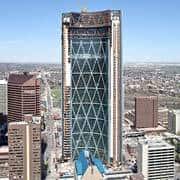In Calgary, Canada, a 236 m high office tower is currently being constructed. “The Bow” is 
For painting, mounting of the fire protection cladding as well as the insulation and installation of the piping system, the sub contractors imposed various requirements concerning working area dimensions and potential loads. Installation of platforms at distances of 2.50 m over the entire height of the building was requested. One of the most important requirements to be fulfilled for all sub-contractors was to ensure that the working platforms were as close as possible to the complex steel structure whose main beams ascended at an angle of 76°. In addition, the front of the building is curved like a crescent.
Together with the Ledcor team, PERI developed a solution based on the PERI UP Rosett Flex scaffolding. In the process, the modular scaffold system has once again proven its high degree of flexibility and has shown itself to be extremely adaptable to suit the curved building layout and special form of the supporting structure – all requirements of both the client and sub-contractors have been fulfilled.
The modular PERI UP Rosett Flex scaffolding has a very wide range of applications. The metric grid dimensions along with the 25 cm and 37.5 cm decking widths provide maximum flexibility. Rosett nodes at spacings of 50 cm are especially rigid and allow connecting possibilities in all directions. Thanks to these characteristics, the modular scaffold has been able to fulfil the stringent technical requirements for construction of “The Bow”. This flexibility and high load-bearing capacity with only a small number of diagonals make the PERI UP solution quick and cost-effective.
For work on the steel construction, the diagonally-positioned profiles must be accessible from all sides. The required cantilevers are realised with brackets and node bracing. The brackets have a high load-bearing capacity and can be mounted at any height – regardless of the decking or ledger levels already installed.
Through the use of corner plates for the inside corners, the working areas can be adapted with minimum gap to the inclined steel components. In addition, adapting to the complex steel sculpture is also achieved by changing the direction of the decking: the span direction of the decks can be changed within a scaffold bay at any point – several times if required. Thanks to these possibilities, the form of the scaffold can be optimally adapted to match the steel structure of the building.
The PERI UP industrial decking with system widths of 25 cm allow working platforms and access means to be completely covered without any gaps. The surface of the decking is perforated and extremely slip-resistant. Due to this, the decks are ideally suited for use in those working areas where safety against slipping has a high priority. Another big advantage is the quick and safe installation: the integrated lock against lifting secures the decking without the need of any additional measures, and immediately after mounting has taken place.
For accessing the individual working areas, PERI UP steel staircases are used. The staircase fulfils the highest requirements regarding loads and accessibility: with a permissible load of 3.0 kN/m² and a width of 100 cm, the stairs are generously dimensioned and stable to allow site personnel to move in opposite directions at the same time. Installation is simple and fast. The stair stringers are mounted first and subsequently covered with the lightweight individual steps that interlock during assembly. The top step secures all the others.
PERI logic simplifies and accelerates assembly of the PERI UP scaffolding – even at great heights. The low weight of the individual system components, and the fact that each system part can be handled by only one person, facilitates fast and effortless operations. The high rigidity of the PERI UP ledger connections reduces the number of levels that need to be braced as well as reducing the amount of required diagonals. All PERI UP system components are compatible with each other which means working platforms, stairs and guardrails are easy to install. The “gravity lock” self-locking ledger connection provides a very high level of working and assembly safety: when mounting the ledger, the wedge drops automatically into the opening of the rosette through its own gravitational force and securely locks into position. PERI UP has been tried and tested over many years and the modular scaffold system fully complies with system scaffolding requirements according to European Standards.
“The Bow” is the future headquarters for the EnCana Corporation, a company operating in the oil and gas industry. Not only is the distinctive appearance of the office tower extraordinary but also the building concept itself: To create a best possible working environment, the London architects Foster + Partners first discussed the ideas and needs together with the companies’ employees before planning the building.
The building provides employees with working areas with daylight and natural ventilation. The spacious architecture, open work areas as well as three “sky gardens” facilitate the cooperation of the teams Form and orientation of the building have also been ideally adapted to suit the local climatic conditions. A glass atrium extends in a south-westerly direction over the entire building height of 236 m, an intelligent energy concept for optimum utilization of solar energy and minimum energy consumption. The distinctive design with a diagonal grid of steel beams also provides an especially good structural behaviour. For the first time in North America, this combination of a diagonal support structure and, at the same time, curved shape of a building has been realised.

